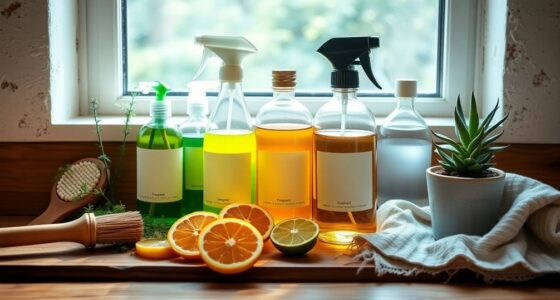When deciding between steam cleaning and chemical cleaning for your home, steam cleaning stands out. It effectively sanitizes surfaces using just high-temperature steam, eliminating up to 99.9% of bacteria and allergens without harmful residues. This method is eco-friendly and can save you money long-term since you won’t need to buy chemicals regularly. Plus, it’s safer for homes with kids and pets. Want to know more about the benefits and drawbacks of each method?
Key Takeaways
- Steam cleaning effectively eliminates up to 99.9% of bacteria and allergens without harsh chemicals, promoting a healthier home environment.
- Chemical cleaners may leave harmful residues, posing health risks, especially for sensitive individuals, and contributing to indoor air pollution.
- Although steam cleaning has a higher initial cost, it offers long-term savings by reducing the need for ongoing chemical purchases.
- Steam cleaning requires longer drying times compared to the quicker drying of chemical cleaning methods, which may affect immediate access to cleaned areas.
- Eco-friendly steam cleaning supports sustainability by using only water, while chemical cleaning can involve toxic substances that harm the environment.
Understanding Steam Cleaning
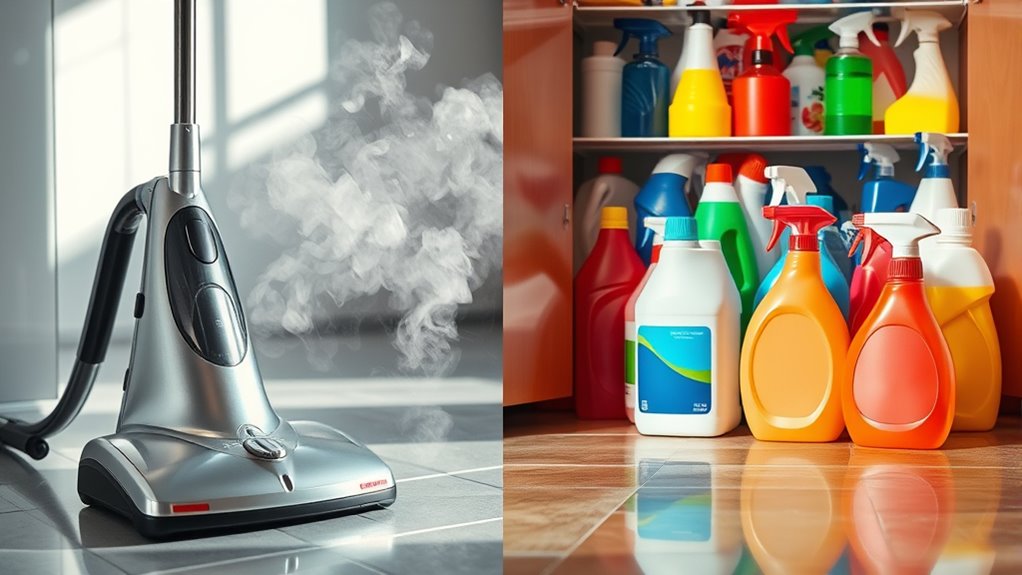
When you choose steam cleaning, you’re opting for a powerful method that uses high-temperature steam to break down dirt and sanitize surfaces without harsh chemicals.
Steam cleaning offers an effective deep clean for various surfaces, including tile, grout, and carpets, making it versatile for any home. The benefits of steam extend beyond cleanliness; it naturally kills bacteria, viruses, and allergens, promoting a healthier living environment—especially important if you have children or pets. Regular use of steam cleaning can also contribute to improving indoor air quality, as it helps eliminate dust and allergens that can accumulate in your home, thereby reducing the risk of respiratory issues. Additionally, using steam cleaning can enhance indoor air quality by minimizing the presence of chemical pollutants that traditional cleaners may leave behind. Furthermore, steam cleaning is an environmentally friendly option, as it reduces chemical usage and can support a more sustainable lifestyle. Moreover, it can lead to a significant reduction in energy consumption by minimizing the need for additional cleaning resources and products.
Unlike traditional chemical cleaning products, steam cleaning minimizes drying time due to the quick evaporation of steam, saving you time and effort.
Brands like McCulloch provide a range of models tailored to different cleaning needs, ensuring you have the right tools for a thorough, chemical-free clean.
Exploring Chemical Cleaning Methods
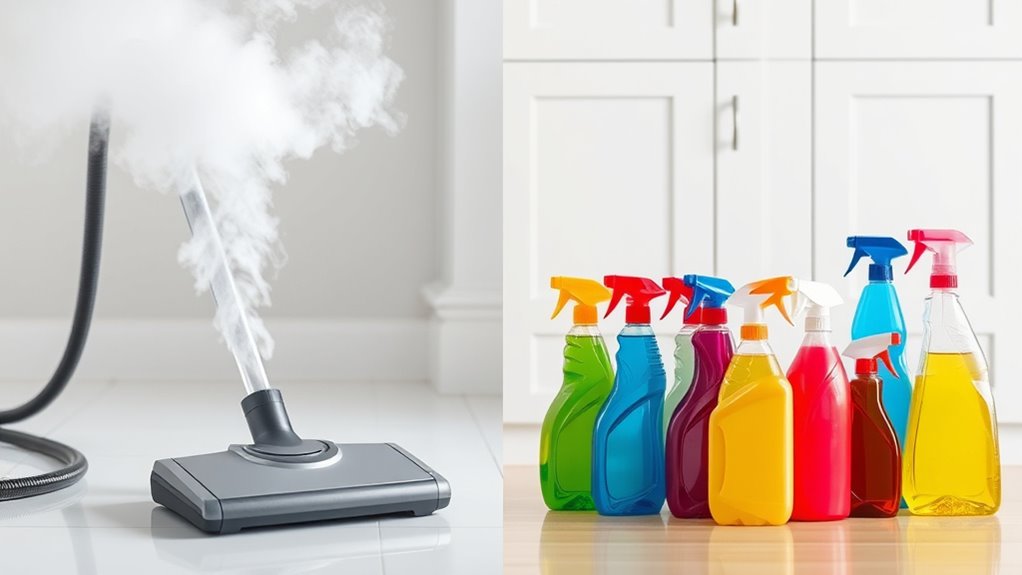
When you’re considering chemical cleaning methods, it’s important to know the different types of cleaners available and how they work. Some cleaners are designed to eliminate allergens and improve indoor air quality, similar to how air purifiers function by targeting common allergens. Additionally, understanding the importance of regular professional cleaning can help ensure that chemical residues are properly managed. You’ll also want to think about safety, as some chemicals can pose health risks if not used properly. Regular professional cleaning is recommended to maintain optimal cleanliness and safety in your home. Understanding these factors will help you make informed decisions for effective and safe cleaning. Furthermore, knowing about filial responsibility laws can guide families in ensuring that elder care is not only effective but also financially manageable. Additionally, consider the impact of absorbed fixed overhead costs when budgeting for cleaning services, as these costs can affect your overall financial planning.
Types of Chemical Cleaners
Chemical cleaning methods offer a variety of solutions tailored to tackle specific cleaning challenges. You’ll find a range of chemical solutions, including all-purpose cleaners, bleach, ammonia, and specialized agents for tasks like degreasing or stain removal. Many of these cleaning chemicals contain surfactants that reduce water’s surface tension, enhancing their ability to penetrate and lift dirt and grime effectively. However, the effectiveness of these agents can vary based on the surface type and the nature of the stain. Additionally, air purifiers can help reduce pollutants and allergens in the home post-cleaning. Incorporating unique homemade fruit juice recipes can also promote health and wellness, contributing to a cleaner living environment overall. It’s crucial to take into account health and safety, as some cleaners may leave residues that pose risks, especially for individuals with allergies or sensitivities to harsh chemicals. Regular cleaning can significantly reduce allergens and pollutants, ensuring a safer environment for everyone. Always choose cleaning agents suited to your specific needs to guarantee ideal results. Regular maintenance of your cleaning tools, including vacuum cleaners, is essential for optimal performance and effectiveness. Implementing a budget-friendly maintenance plan for appliances can also enhance their longevity and efficiency, ensuring that your home remains clean and functional.
Safety Considerations in Cleaning
Using chemical cleaners can effectively tackle tough stains and dirt, but safety considerations shouldn’t be overlooked.
These chemical cleaning methods often involve harsh agents that leave harmful residues, posing health risks to you, your children, and pets. Exposure to certain cleaners can lead to respiratory issues and skin irritation, especially for those with allergies. Additionally, many products contain volatile organic compounds (VOCs), contributing to indoor air pollution and long-term health effects. Always guarantee proper ventilation when using these cleaners to minimize inhaling toxic fumes. Furthermore, consider the long-term environmental impact, including potential water contamination from chemicals used in cleaning. Eco-friendly alternatives are available and can provide safer, healthier options for your home without compromising cleanliness. Moreover, adopting data-driven decision-making can help you choose safer cleaning products and practices for your household. Additionally, using natural cleaners can often be just as effective and contribute to overall health without the risks associated with chemical exposure. In addition, consider utilizing essential oils like lavender or chamomile as natural alternatives for cleaning and freshening your space. Using air purifiers with HEPA filters can further enhance indoor air quality by reducing harmful particles and allergens.
Make informed choices for a safer living space.
Cleaning Power: Effectiveness of Each Method
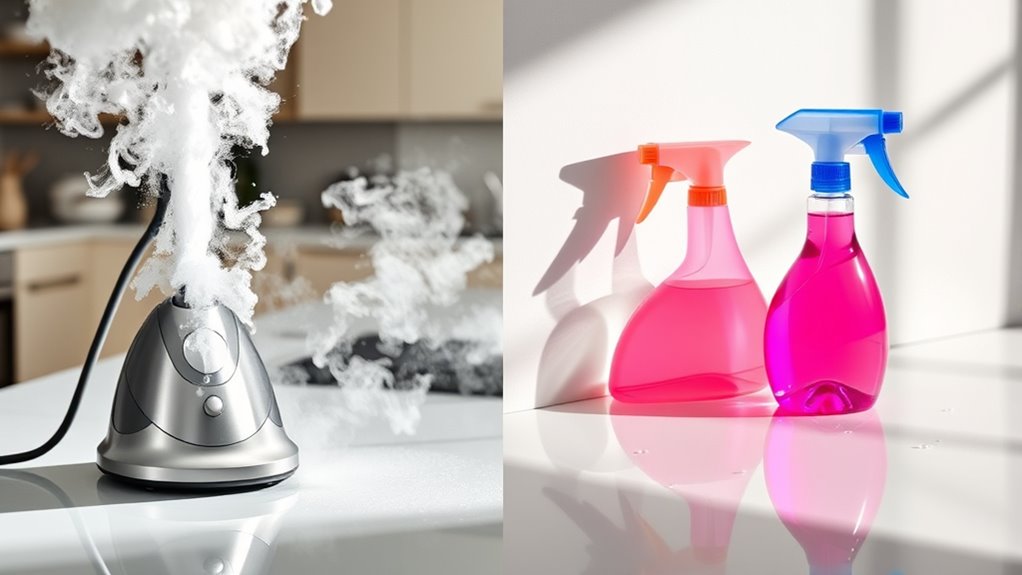
While both steam cleaning and traditional chemical cleaning aim to achieve cleanliness, steam cleaning often proves to be the more effective method.
Its cleaning power comes from high-temperature steam that penetrates deep into surfaces, breaking down dirt, grease, and stains effortlessly. Unlike traditional chemical cleaning, which can leave residues and may struggle to sanitize surfaces effectively, steam cleaning can eliminate up to 99.9% of bacteria, viruses, and allergens without harsh chemicals. This makes it a safer choice for homes with children or pets, especially considering the need for newborn sunscreens to protect delicate skin from harmful substances. Additionally, steam cleaning reaches hidden grime and biofilms that other methods might miss, enhancing its overall effectiveness. Regular use of steam cleaning can also help in preventing cross-contact in areas where food is prepared, contributing to a hygienic environment. Furthermore, steam cleaning can aid in reducing allergens in the air, promoting better indoor air quality for all inhabitants. Moreover, using steam cleaning can be more cost-effective in the long run compared to traditional methods, as it often reduces the need for additional cleaning supplies.
With less physical effort required, you’ll find steam cleaning to be a superior option for maintaining a hygienic environment.
Time Efficiency: How Quickly Can You Clean?
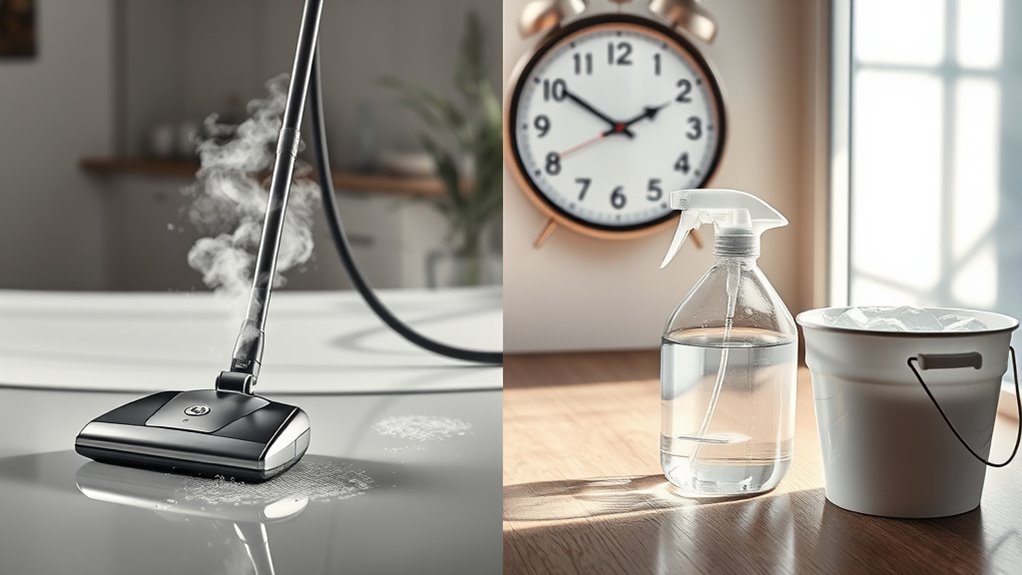
When it comes to time efficiency, steam cleaning often wins out over chemical methods.
You can set up quickly and get to work without the hassle of multiple steps.
Plus, surfaces dry faster, meaning you can get back to using your space sooner.
Setup and Preparation Speed
Although you might appreciate the effectiveness of traditional chemical cleaning, steam cleaning offers a remarkably quicker setup and preparation process.
Here’s how steam cleaning enhances time efficiency:
- Minimal Setup: You can be ready to clean various surfaces in just a few minutes.
- Fewer Steps: Unlike traditional cleaning methods, you won’t waste time gathering multiple tools or mixing solutions.
- Simultaneous Cleaning: Steam cleaning can tackle multiple surfaces at once, reducing the need for separate processes.
- Less Water: With minimal water usage, you avoid excess moisture that leads to longer drying times.
Cleaning Process Duration
If you’re looking for an efficient cleaning process, steam cleaning stands out by minimizing the time spent on preparation and scrubbing. This method allows you to tackle multiple surfaces at once, greatly reducing the overall cleaning process duration. In contrast, traditional cleaning methods can rely on a longer sequence of steps, extending your time spent cleaning.
Here’s a quick comparison of the two methods:
| Cleaning Method | Average Duration |
|---|---|
| Steam Cleaning | Shorter setup, longer drying time |
| Chemical Cleaning | Longer setup, quicker drying |
Even though steam cleaning may require a drying time of up to several hours, it’s often more efficient overall, reducing the need for re-cleaning due to chemical residues.
Drying Time Comparison
While steam cleaning excels in reducing overall cleaning time, its longer drying times can pose challenges. Typically, steam cleaning requires drying times of 45 minutes to several hours due to the moisture it introduces.
In contrast, chemical cleaning methods dry much faster, making them ideal for quick cleanups. Here’s a quick comparison of drying times:
- Steam Cleaning: 45 minutes to several hours.
- Chemical Cleaning: Usually dries within 30 minutes to an hour.
- Extraction Impact: Poor extraction can extend drying times for steam cleaning.
- Usability: Chemical cleaning allows immediate access to spaces, unlike steam cleaning.
If time efficiency’s your priority, chemical cleaning might be the better option, while steam cleaning is perfect for deep cleaning despite its longer drying time.
Health and Safety Considerations
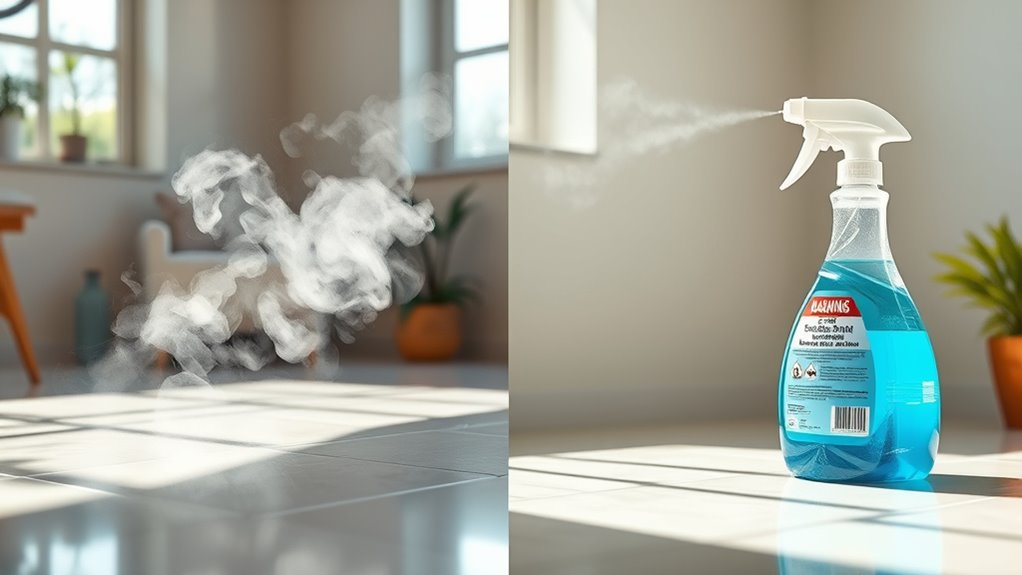
When considering health and safety, steam cleaning stands out as a superior option for your home. This method uses high-temperature steam to kill 99.9% of bacteria and viruses, eliminating the need for harsh chemical cleaners that can pose health risks.
If you or your family members have allergies, steam cleaning greatly reduces indoor allergens like dust mites and pet dander, creating a healthier living environment.
Plus, it’s eco-friendly, relying solely on water, which minimizes moisture and the risk of mold growth. Unlike traditional cleaners that leave toxic residues, steam cleaning promotes a safer atmosphere for homes with children and pets.
Steam cleaning is eco-friendly, using just water to reduce moisture and avoid toxic residues, ensuring a safer home for families.
Choosing steam cleaning means prioritizing your family’s health while keeping your home fresh and clean.
Environmental Impact: Which Method Is Greener?
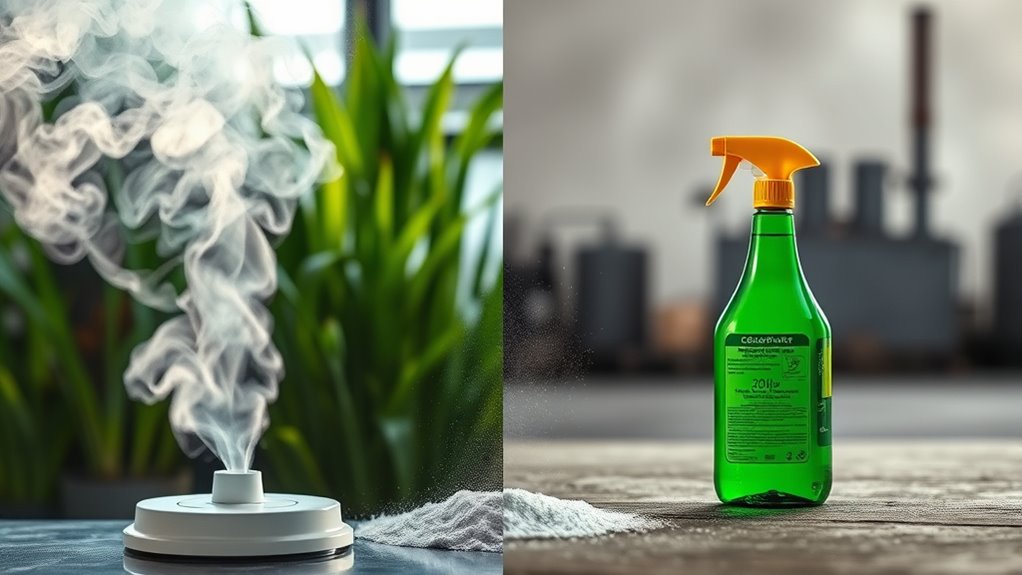
Steam cleaning not only prioritizes health and safety but also stands out for its environmental benefits. By choosing steam cleaning, you’re opting for a greener method that considerably reduces your environmental impact.
Here are some key advantages:
- Minimal Waste: Steam cleaning generates little wastewater, preventing contamination of water sources.
- No Harmful Chemicals: It effectively kills bacteria without synthetic chemicals, promoting healthier indoor air quality.
- Sustainable Practices: Steam cleaning uses less water and energy compared to producing and using chemical cleaners.
- Reduced Toxicity: Unlike chemical cleaning, it avoids cross-contamination and residual toxicity, protecting both human health and the environment.
Cost Analysis: Long-Term Expenses
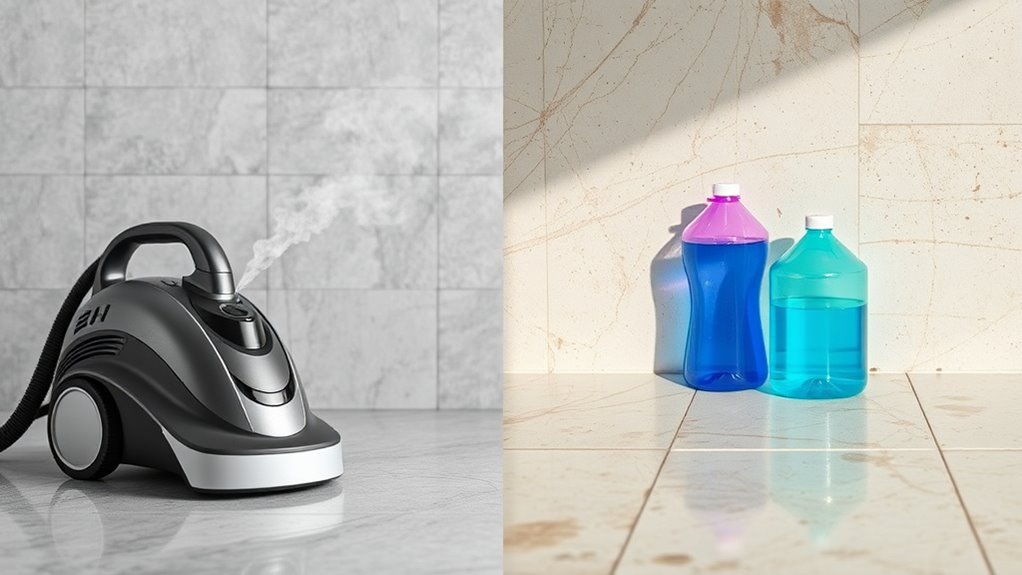
Choosing the right cleaning method can greatly impact your long-term expenses, especially when weighing steam cleaning against chemical cleaning.
While steam cleaning requires a higher initial investment, typically ranging from $399 to $499 AUD for quality machines, it can save you money over time. You’ll reduce the need for ongoing purchases of chemical cleaners, which can add up quickly.
Additionally, steam cleaning extends the life of your carpets and upholstery, decreasing the chances of premature replacements. By minimizing allergens and harmful chemicals, you might also lower health-related expenses linked to poor indoor air quality.
Although steam cleaning has longer drying times, its efficiency means you’ll clean less often, ultimately leading to significant cost savings in both time and supplies.
Making the Right Choice for Your Home
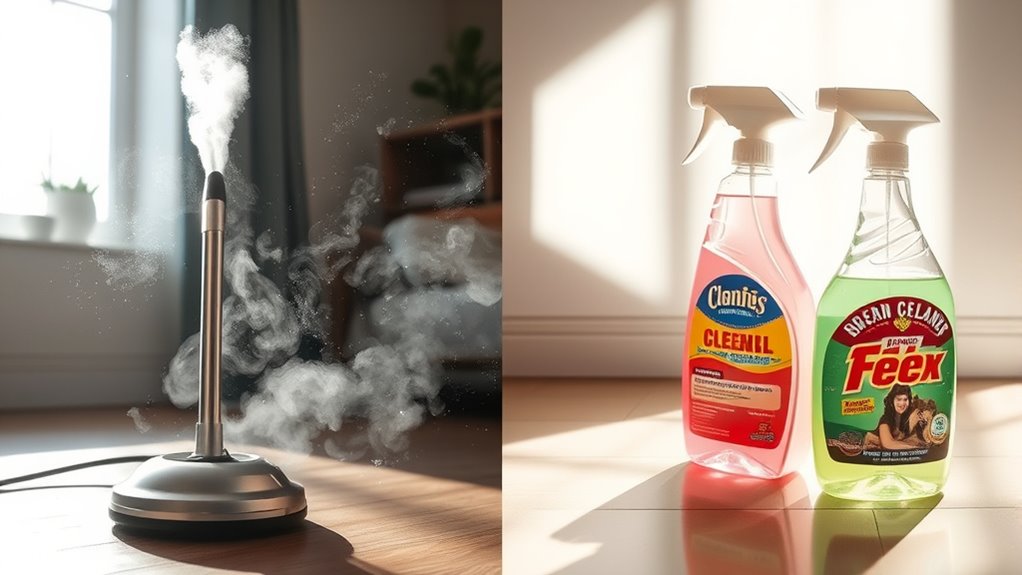
Deciding on the best cleaning method for your home can be a game-changer, especially if you have kids or pets.
Consider the following factors to make the right choice:
- Safety: Steam cleaning sanitizes surfaces without harsh chemicals, reducing health risks for your family.
- Effectiveness: For deep cleaning and clean carpets, steam cleaning provides the best results by eliminating allergens and bacteria.
- Time Efficiency: Steam cleaning requires less scrubbing and dries quickly, allowing you to access rooms faster.
- Long-Term Savings: While steam cleaning may involve an upfront cost, it saves money on chemical cleaners over time.
Evaluate your specific cleaning needs to determine whether steam or chemical cleaning is the right fit for your home.
Frequently Asked Questions
Is Steam Cleaning Better Than Chemicals?
You’ll find that steam cleaning often outshines chemical cleaning in many ways. It effectively eliminates dirt and bacteria, ensuring a safer environment, especially for homes with kids and pets.
With high-temperature steam, you sanitize surfaces without harsh chemicals, reducing allergens and improving indoor air quality. Plus, it usually requires less water, resulting in quicker drying times and lower mold risk.
While the initial cost can be higher, the long-term benefits make it worthwhile.
Which Is Better, Steam or Chemical Carpet Cleaning?
When it comes to carpet cleaning, think of it as choosing between a gentle rain and a harsh storm.
Steam cleaning’s your best bet. It penetrates deep, removing dirt and bacteria while remaining eco-friendly, unlike chemical cleaners that leave behind harmful residues.
Sure, it takes longer to dry, but you’ll appreciate the long-term benefits, like extended carpet life and better cleanliness.
In the battle of carpet care, steam’s the hero you need.
Is Steam Cleaning Better Than Bleach?
When you’re deciding if steam cleaning is better than bleach, consider the benefits of steam.
It sanitizes surfaces effectively at high temperatures, killing almost all bacteria without harsh chemicals. Unlike bleach, it won’t leave harmful residues or strong odors, making it safer for kids and pets.
Plus, steam penetrates deep, removing dirt and allergens while being eco-friendly.
You’ll find steam cleaning not only cleans better but also makes your home a healthier place.
What Floors Should Not Be Steam Cleaned?
When it comes to cleaning your floors, think of steam as a double-edged sword.
While it’s great for some surfaces, it can spell disaster for others. You shouldn’t steam clean unsealed hardwood, laminate, natural stone like marble, or older vinyl floors.
Each of these materials can suffer from moisture damage or warping, just like a delicate flower wilting in the rain.
Protect your floors by choosing methods that suit their unique needs.
Conclusion
In the battle of steam cleaning versus chemical cleaning, your home deserves the best ally. Picture steam as a gentle warrior, wielding heat to banish dirt, while chemicals charge in with brute force. Ultimately, it’s about what fits your lifestyle and values. If you seek a fresh, eco-friendly approach, steam might be your champion. But if you need quick, powerful results, chemicals could be your trusty steed. Choose wisely, and let your home shine like never before!



